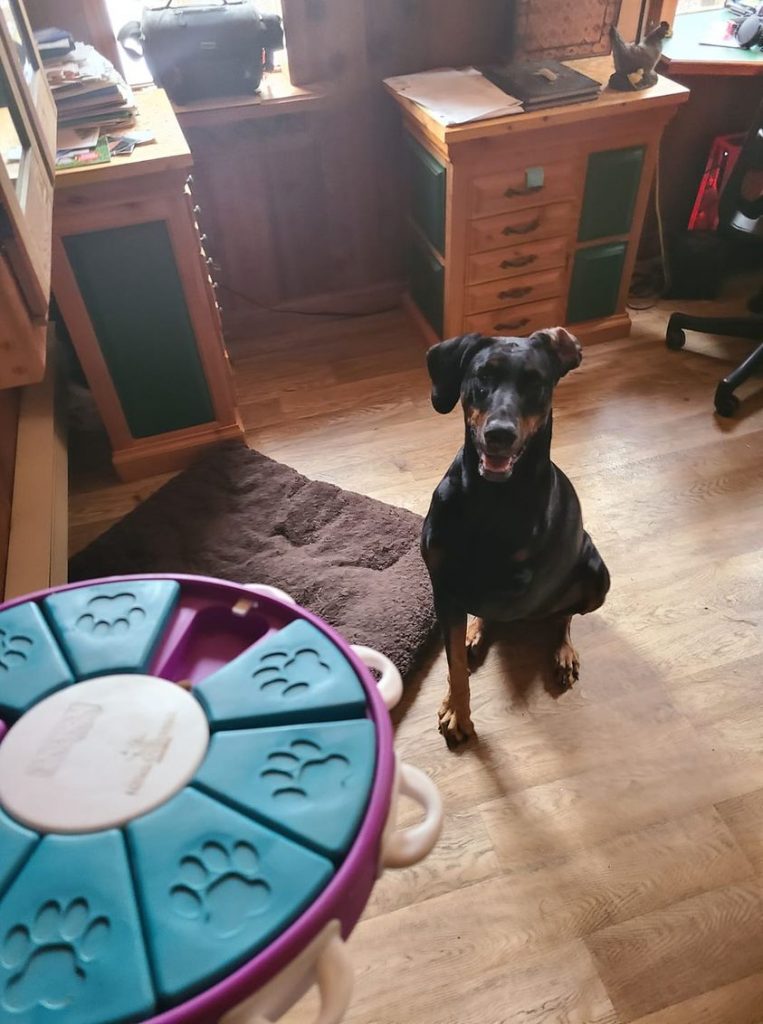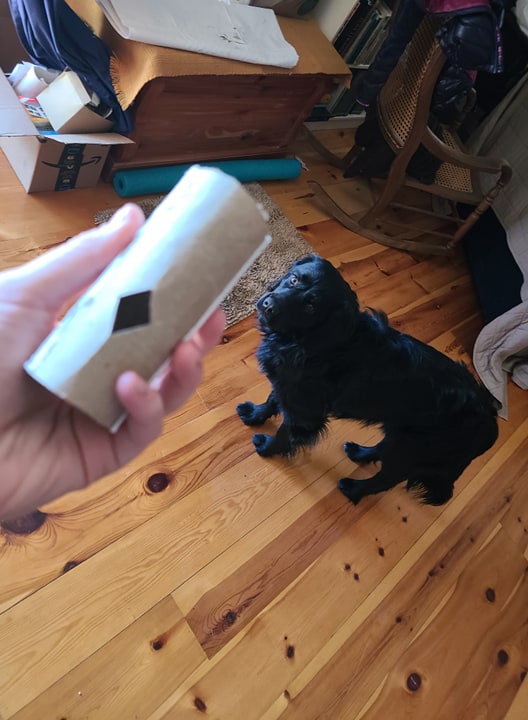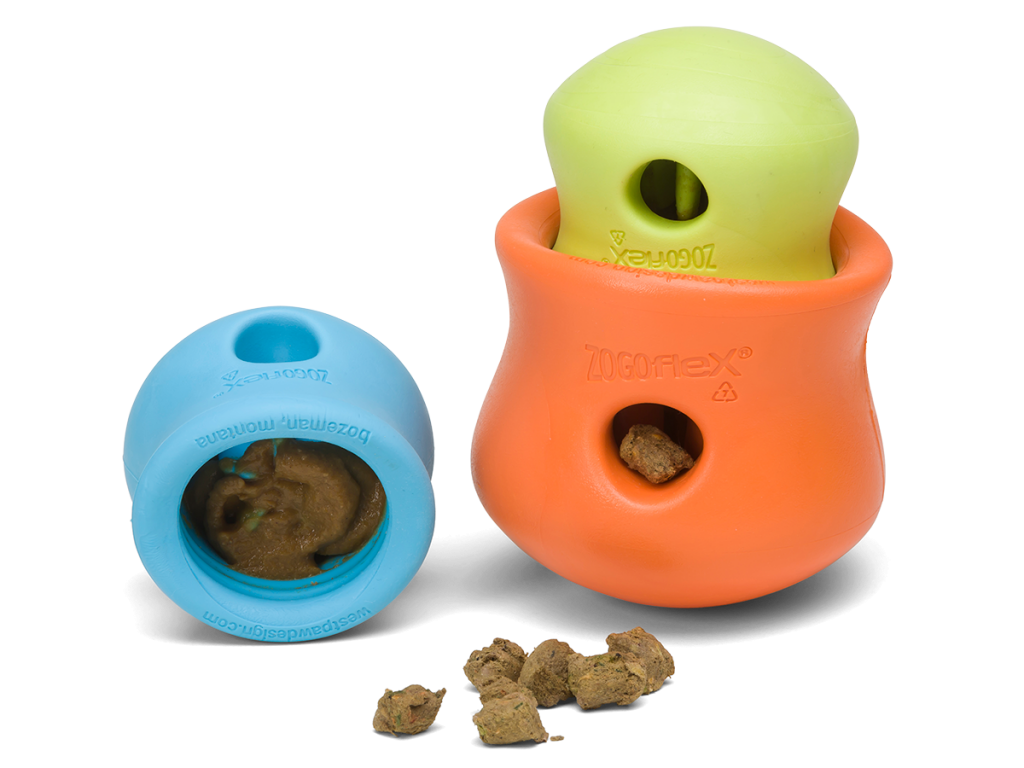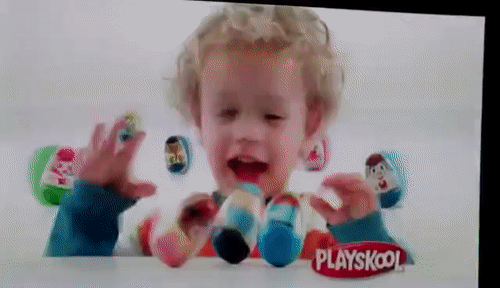
Dog trainers – myself included – are notoriously obsessed with enrichment for dogs. It is the piece that, in my experience, is missing in a lot of pet dog’s lives and makes a huge impact on quality of life and good behaviour. Often, owners walk their dogs and feed their dogs and give them water and then just want them to chill out. And sometimes, that’s fine! But sometimes, that’s really boring. There is more to life than just walks and having basic needs met; enter: enrichment!
So… WTF is “Enrichment” Anyways?
Environmental or behavioral enrichment is the process of manipulating an animal’s environment to increase physical activity & normal species typical behavior that satisfies the animal’s physical and psychological needs. It reduces stress and therefore promotes overall health by increasing an animal’s perception of control over their environment and by occupying their time. Techniques utilized to enrich an environment generally fall into 5 categories: food based enrichment, sensory enrichment (sight, smell, touch, hear, taste), novel objects, social enrichment, positive training. Do remember that to be effective, the animal can not be made fearful and must actually utilize or engage in the activity for it to be enriching.
Ohio State University College of Veterinary Medicine, “Indoor Pet Initiative”
Each of those categories could well be it’s own blog post, though in my head they are sort of a giant 5-pronged venn diagram; which is to say, there’s lots of overlap. For today, we are going to focus mainly on food based enrichment (with the understanding that there is overlap!)
My Four Favourite *Easy* Enrichment Toys (and Their Free Alternatives!)
I love enrichment/puzzle toys. They are the perfect combination of excellent enrichment for dogs and lazy enrichment from me. The dogs love them, and I love that they keep the dogs busy and happy and mentally stimulated. The downside is that toys get expensive after a while and clutter your space. Don’t get me wrong – I’m okay with that and buy them by the boatload – but for each of my favourites, I’ll provide you a free alternative with things you likely already have in the house!
1. West Paw Toppl
This is my favourite toy of all time. It is a great alternative to the ever-popular Kong toy. I like it better for a couple reasons:
- If you are stuffing it with wet food and freezing it (my preferred method of use!), the main opening is bigger which means dogs who get frustrated easily and give up on a Kong will have better success with the Toppl.
- They stack (so, if you get a large one and a smaller one, you can put the openings together to make a bigger different style toy), making them also a great way to slow down mealtimes if you fill them with kibble.
Free Alternative: Stuffed Marrow Bones
For the stuff-and-freeze method, I use old bones – like the marrow bones you can buy dirt cheap at the grocery store for broth. Stuff with whatever you normally use, and freeze. Ta-Da!
2. Kong Wobbler
While I did say above I’m not the biggest fan of the traditional Kong because of the small opening that a lot of dogs find frustrating, their Wobbler is definitely one of my favourites. I might be aging myself here, but to give you an idea of how it works, think of a Weeble toy. You know… Weeble’s wobble but they don’t fall down?
So the wobbler works similarly to if you stack two Topples with kibble but is nigh indestructible and has a weighted base. It’s only downside, in my experience? It’s hard plastic and if your pup is using it on hardwood, it is loud.
Free Alternative: Empty Toilet Paper Roll
Yep, you read that right. Empty toilet paper roll. It’s easy! Cut a small hole in an empty roll. Fold in the sides. Put in kibble or treats. Done! Bonus points: This is a super easy and fun one to make with kids!




3. Snuffle Mat
I’m not attached to any particular brand of snuffle mat, but I swear, this is one toy that is definitely worth the clutter around your home. It encourages sniffing and foraging instincts and I have never met a dog who doesn’t love it. For new rescues/anxious dogs in general, I’ve had a lot of success with building confidence and trust by introducing the snuffle mat. It is a very low frustration activity, and doesn’t move or make weird noises (like the others above) so is perfect for enrichment for dogs who are more skittish.
Free Alternative: Snuffle Mat!
Okay, a bit of a cheat. I love snuffle mats so much I’m just trying to sell you on one. But! You don’t have to buy it (though if you’re lazy like me, it’s totally okay to!). People DIY snuffle mats all the time, and it actually doesn’t look that hard.
Okay, okay, fine. That was a bit of a cheat. Have another free alternative.
Free Alternative: Scatter Feed in Grass
My dogs love when I grab a handful of kibble, go out to the yard, throw it in the air to make it rain, and yell, “Find it!”. It really can be that easy.
(I told you enrichment is great if you’re feeling lazy!)
4. Slow Bowls
Slow bowls are one of the easiest forms of enrichment to incorporate into your day. They’re literally just bowls with sort of maze-like structures in them. You have to feed your your dog anyways – why not a slow bowl instead of a regular bowl? Bonus points: if you have a dog who inhales their food and then pukes, this is a great solution.
Free Alternative: Empty Egg Cartons or Muffin Trays
Kibble in a muffin tray or empty egg cartons are a super easy slow feed option too. If your dog is too quick and you want to add a challenge mode, you can easily put a ball on top of the kibble in the muffin tray that they have to pull out to get to their food.
And that’s it!
Four super easy ways to incorporate enrichment into your daily life – and the nice thing about these easy options are that they don’t take much in the way of interaction or supervision from you (though, of course, always supervise your dog if they’re likely to ingest toys or egg cartons).
There are way more fancy and complicated enrichment or puzzle toys out there, and I love them too. I’ll link a couple brands and you can peruse and just see what jumps out to you and give it a try! Your dog will thank you for it. They tend to have more small pieces or higher challenge and thus frustration levels though, so they do require more active supervision and interaction with your dog while doing them. If you’re curious, check out:
Happy Training!
Note: The links in this article are affiliate links, but I promise I wouldn’t recommend products I don’t personally use and love!





